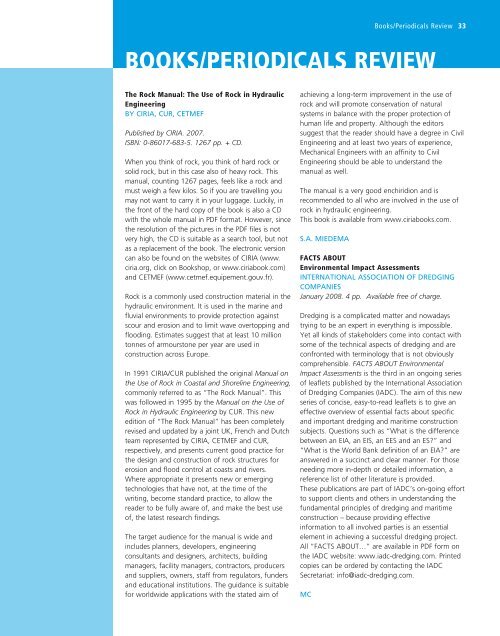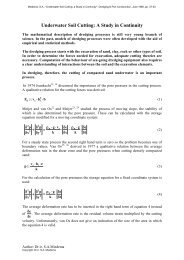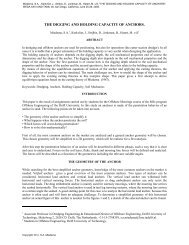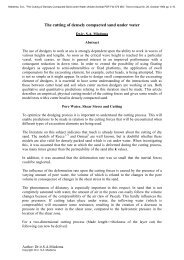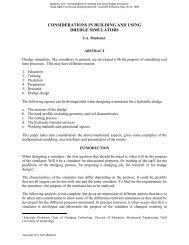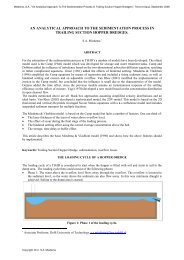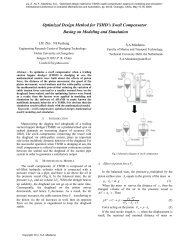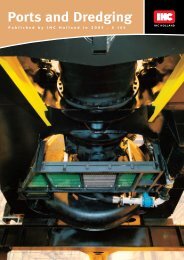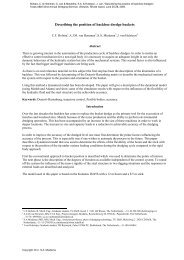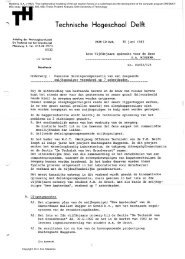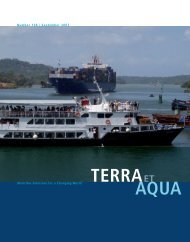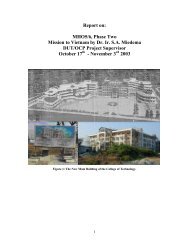The rock manual - Dredging Engineering Research Laboratory
The rock manual - Dredging Engineering Research Laboratory
The rock manual - Dredging Engineering Research Laboratory
You also want an ePaper? Increase the reach of your titles
YUMPU automatically turns print PDFs into web optimized ePapers that Google loves.
Books/Periodicals Review 33BOOKS/PERIODICALS REVIEW<strong>The</strong> Rock Manual: <strong>The</strong> Use of Rock in Hydraulic<strong>Engineering</strong>BY CIRIA, CUR, CETMEFPublished by CIRIA. 2007.ISBN: 0-86017-683-5. 1267 pp. + CD.When you think of <strong>rock</strong>, you think of hard <strong>rock</strong> orsolid <strong>rock</strong>, but in this case also of heavy <strong>rock</strong>. This<strong>manual</strong>, counting 1267 pages, feels like a <strong>rock</strong> andmust weigh a few kilos. So if you are travelling youmay not want to carry it in your luggage. Luckily, inthe front of the hard copy of the book is also a CDwith the whole <strong>manual</strong> in PDF format. However, sincethe resolution of the pictures in the PDF files is notvery high, the CD is suitable as a search tool, but notas a replacement of the book. <strong>The</strong> electronic versioncan also be found on the websites of CIRIA (www.ciria.org, click on Bookshop, or www.ciriabook.com)and CETMEF (www.cetmef.equipement.gouv.fr).Rock is a commonly used construction material in thehydraulic environment. It is used in the marine andfluvial environments to provide protection againstscour and erosion and to limit wave overtopping andflooding. Estimates suggest that at least 10 milliontonnes of armourstone per year are used inconstruction across Europe.In 1991 CIRIA/CUR published the original Manual onthe Use of Rock in Coastal and Shoreline <strong>Engineering</strong>,commonly referred to as “<strong>The</strong> Rock Manual”. Thiswas followed in 1995 by the Manual on the Use ofRock in Hydraulic <strong>Engineering</strong> by CUR. This newedition of “<strong>The</strong> Rock Manual” has been completelyrevised and updated by a joint UK, French and Dutchteam represented by CIRIA, CETMEF and CUR,respectively, and presents current good practice forthe design and construction of <strong>rock</strong> structures forerosion and flood control at coasts and rivers.Where appropriate it presents new or emergingtechnologies that have not, at the time of thewriting, become standard practice, to allow thereader to be fully aware of, and make the best useof, the latest research findings.<strong>The</strong> target audience for the <strong>manual</strong> is wide andincludes planners, developers, engineeringconsultants and designers, architects, buildingmanagers, facility managers, contractors, producersand suppliers, owners, staff from regulators, fundersand educational institutions. <strong>The</strong> guidance is suitablefor worldwide applications with the stated aim ofachieving a long-term improvement in the use of<strong>rock</strong> and will promote conservation of naturalsystems in balance with the proper protection ofhuman life and property. Although the editorssuggest that the reader should have a degree in Civil<strong>Engineering</strong> and at least two years of experience,Mechanical Engineers with an affinity to Civil<strong>Engineering</strong> should be able to understand the<strong>manual</strong> as well.<strong>The</strong> <strong>manual</strong> is a very good enchiridion and isrecommended to all who are involved in the use of<strong>rock</strong> in hydraulic engineering.This book is available from www.ciriabooks.com.S.A. MIEDEMAFACTS ABOUTEnvironmental Impact AssessmentsINTERNATIONAL ASSOCIATION OF DREDGINGCOMPANIESJanuary 2008. 4 pp. Available free of charge.<strong>Dredging</strong> is a complicated matter and nowadaystrying to be an expert in everything is impossible.Yet all kinds of stakeholders come into contact withsome of the technical aspects of dredging and areconfronted with terminology that is not obviouslycomprehensible. FACTS ABOUT EnvironmentalImpact Assessments is the third in an ongoing seriesof leaflets published by the International Associationof <strong>Dredging</strong> Companies (IADC). <strong>The</strong> aim of this newseries of concise, easy-to-read leaflets is to give aneffective overview of essential facts about specificand important dredging and maritime constructionsubjects. Questions such as “What is the differencebetween an EIA, an EIS, an EES and an ES?” and“What is the World Bank definition of an EIA?” areanswered in a succinct and clear manner. For thoseneeding more in-depth or detailed information, areference list of other literature is provided.<strong>The</strong>se publications are part of IADC’s on-going effortto support clients and others in understanding thefundamental principles of dredging and maritimeconstruction – because providing effectiveinformation to all involved parties is an essentialelement in achieving a successful dredging project.All “FACTS ABOUT…” are available in PDF form onthe IADC website: www.iadc-dredging.com. Printedcopies can be ordered by contacting the IADCSecretariat: info@iadc-dredging.com.MC


